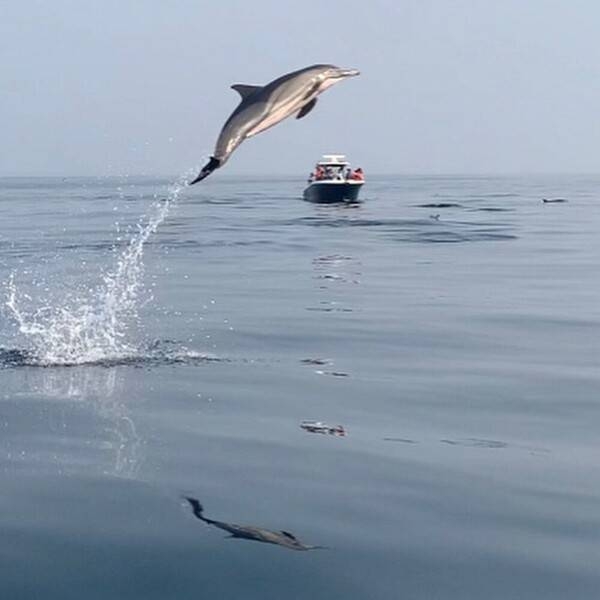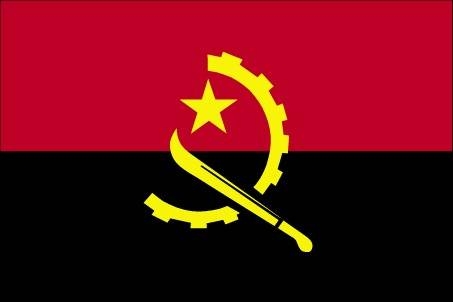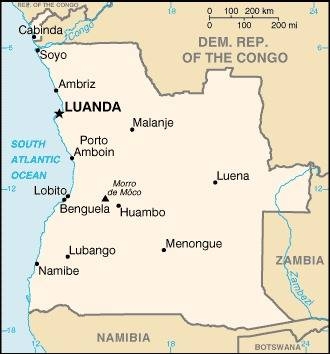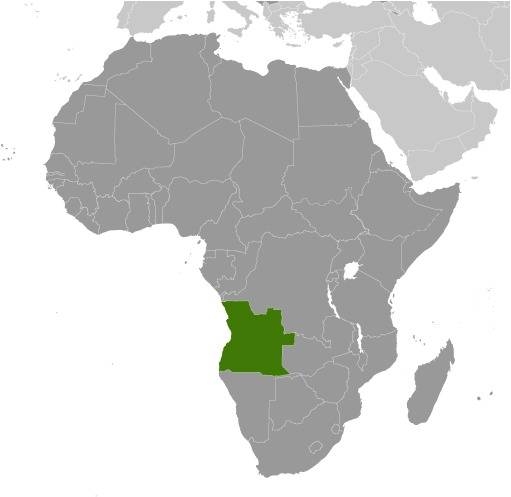Introduction
Background
From the late 14th to the mid 19th century a Kingdom of Kongo stretched across central Africa from present-day northern Angola into the current Congo republics. It traded heavily with the Portuguese who, beginning in the 16th century, established coastal colonies and trading posts and introduced Christianity. By the 19th century, Portuguese settlement had spread to the interior; in 1914, Portugal abolished the last vestiges of the Kongo Kingdom and Angola became a Portuguese colony.
Angola scores low on human development indexes despite using its large oil reserves to rebuild since the end of a 27-year civil war in 2002. Fighting between the Popular Movement for the Liberation of Angola (MPLA), led by Jose Eduardo DOS SANTOS, and the National Union for the Total Independence of Angola (UNITA), led by Jonas SAVIMBI, followed independence from Portugal in 1975. Peace seemed imminent in 1992 when Angola held national elections, but fighting picked up again in 1993. Up to 1.5 million lives may have been lost - and 4 million people displaced - during the more than a quarter century of fighting. SAVIMBI's death in 2002 ended UNITA's insurgency and cemented the MPLA's hold on power. DOS SANTOS stepped down from the presidency in 2017, having led the country since 1979. He pushed through a new constitution in 2010. Joao LOURENCO was elected president in August 2017 and became president of the MPLA in September 2018.
Visit the Definitions and Notes page to view a description of each topic.
Geography
Location
Southern Africa, bordering the South Atlantic Ocean, between Namibia and Democratic Republic of the Congo
Geographic coordinates
12 30 S, 18 30 E
Map references
Africa
Area - comparative
about eight times the size of Georgia; slightly less than twice the size of Texas
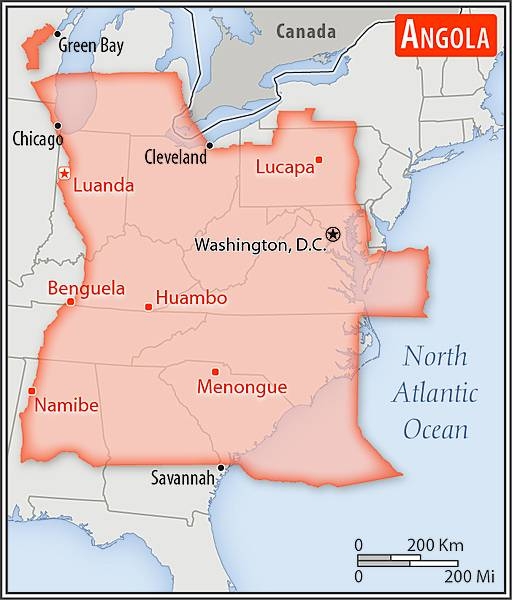
Land boundaries
total: 5,369 km
border countries (4): Democratic Republic of the Congo 2,646 km (of which 225 km is the boundary of discontiguous Cabinda Province); Republic of the Congo 231 km; Namibia 1,427 km; Zambia 1,065 km
Coastline
1,600 km
Maritime claims
territorial sea: 12 nm
contiguous zone: 24 nm
exclusive economic zone: 200 nm
Climate
semiarid in south and along coast to Luanda; north has cool, dry season (May to October) and hot, rainy season (November to April)
Terrain
narrow coastal plain rises abruptly to vast interior plateau
Elevation
highest point: Moca 2,620 m
lowest point: Atlantic Ocean 0 m
mean elevation: 1,112 m
Natural resources
petroleum, diamonds, iron ore, phosphates, copper, feldspar, gold, bauxite, uranium
Land use
agricultural land: 45.7% (2018 est.)
arable land: 3.9% (2018 est.)
permanent crops: 0.3% (2018 est.)
permanent pasture: 41.5% (2018 est.)
forest: 54.3% (2018 est.)
Irrigated land
860 sq km (2014)
Major rivers (by length in km)
Zambezi (shared with Zambia [s], Namibia, Botswana, Zimbabwe, and Mozambique [m]) - 2,740 km; Okavango river source (shared with Namibia and Botswana [m]) - 1,600 km
note – [s] after country name indicates river source; [m] after country name indicates river mouth
Major watersheds (area sq km)
Atlantic Ocean drainage: Congo (3,730,881 sq km)
Indian Ocean drainage: Zambezi (1,332,412 sq km)
Internal (endorheic basin) drainage: Okavango Basin (863,866 sq km)
Major aquifers
Congo Basin, Upper Kalahari-Cuvelai-Upper Zambezi Basin
Population distribution
most people live in the western half of the country; urban areas account for the highest concentrations of people, particularly the capital of Luanda as shown in this population distribution map
Natural hazards
locally heavy rainfall causes periodic flooding on the plateau
Geography - note
the province of Cabinda is an exclave, separated from the rest of the country by the Democratic Republic of the Congo
People and Society
Nationality
noun: Angolan(s)
adjective: Angolan
Ethnic groups
Ovimbundu 37%, Kimbundu 25%, Bakongo 13%, Mestico (mixed European and native African) 2%, European 1%, other 22%
Languages
Portuguese 71.2% (official), Umbundu 23%, Kikongo 8.2%, Kimbundu 7.8%, Chokwe 6.5%, Nhaneca 3.4%, Nganguela 3.1%, Fiote 2.4%, Kwanhama 2.3%, Muhumbi 2.1%, Luvale 1%, other 3.6%; note - data represent most widely spoken languages; shares sum to more than 100% because some respondents gave more than one answer on the census (2014 est.)
Religions
Roman Catholic 41.1%, Protestant 38.1%, other 8.6%, none 12.3% (2014 est.)
Demographic profile
More than two decades after the end of Angola's 27-year civil war, the country still faces a variety of socioeconomic problems, including poverty, high maternal and child mortality, and illiteracy. Despite the country's rapid post-war economic growth based on oil production, about 40 percent of Angolans live below the poverty line and unemployment is widespread, especially among the large young-adult population. Only about 70% of the population is literate, and the rate drops to around 60% for women. The youthful population - about 45% are under the age of 15 - is expected to continue growing rapidly with a fertility rate of more than 5 children per woman and a low rate of contraceptive use. Fewer than half of women deliver their babies with the assistance of trained health care personnel, which contributes to Angola's high maternal mortality rate.
Of the estimated 550,000 Angolans who fled their homeland during its civil war, most have returned home since 2002. In 2012, the UN assessed that conditions in Angola had been stable for several years and invoked a cessation of refugee status for Angolans. Following the cessation clause, some of those still in exile returned home voluntarily through UN repatriation programs, and others integrated into host countries.
Age structure
0-14 years: 47.83% (male 7,758,636/female 7,797,869)
15-24 years: 18.64% (male 2,950,999/female 3,109,741)
25-54 years: 27.8% (male 4,301,618/female 4,740,463)
55-64 years: 3.43% (male 523,517/female 591,249)
65 years and over: 2.3% (male 312,197/female 436,050) (2020 est.)
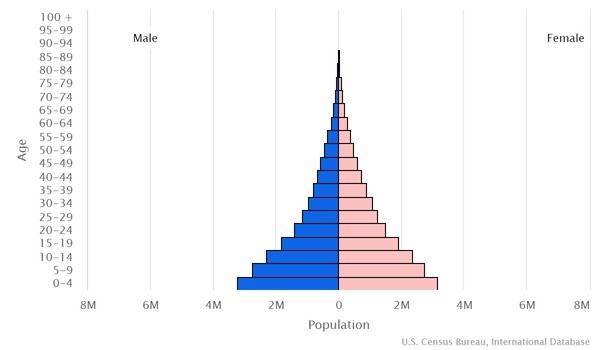
Dependency ratios
total dependency ratio: 91.5
youth dependency ratio: 86.5
elderly dependency ratio: 5
potential support ratio: 20.1 (2021 est.)
Median age
total: 15.9 years
male: 15.4 years
female: 16.4 years (2020 est.)
Population distribution
most people live in the western half of the country; urban areas account for the highest concentrations of people, particularly the capital of Luanda as shown in this population distribution map
Urbanization
urban population: 68.7% of total population (2023)
rate of urbanization: 4.04% annual rate of change (2020-25 est.)
Major urban areas - population
9.292 million LUANDA (capital), 959,000 Lubango, 905,000 Cabinda, 809,000 Benguela, 783,000 Malanje (2023)
Sex ratio
at birth: 1.03 male(s)/female
0-14 years: 1 male(s)/female
15-24 years: 0.95 male(s)/female
25-54 years: 0.91 male(s)/female
55-64 years: 0.89 male(s)/female
65 years and over: 0.59 male(s)/female
total population: 0.95 male(s)/female (2022 est.)
Mother's mean age at first birth
19.4 years (2015/16 est.)
note: data represents median age at first birth among women 20-49
Maternal mortality ratio
241 deaths/100,000 live births (2017 est.)
country comparison to the world: 45Infant mortality rate
total: 58.86 deaths/1,000 live births
male: 64.11 deaths/1,000 live births
female: 53.46 deaths/1,000 live births (2022 est.)
Life expectancy at birth
total population: 62.11 years
male: 60.05 years
female: 64.24 years (2022 est.)
Contraceptive prevalence rate
13.7% (2015/16)
Drinking water source
improved: urban: 81.3% of population
rural: 36.5% of population
total: 66.5% of population
unimproved: urban: 18.7% of population
rural: 63.5% of population
total: 33.5% of population (2020 est.)
Current health expenditure
2.5% of GDP (2019)
Physicians density
0.21 physicians/1,000 population (2018)
Sanitation facility access
improved: urban: 93.7% of population
rural: 30.3% of population
total: 72.7% of population
unimproved: urban: 6.3% of population
rural: 69.7% of population
total: 27.3% of population (2020 est.)
Major infectious diseases
degree of risk: very high (2020)
food or waterborne diseases: bacterial and protozoal diarrhea, hepatitis A, typhoid fever
vectorborne diseases: dengue fever, malaria
water contact diseases: schistosomiasis
animal contact diseases: rabies
Alcohol consumption per capita
total: 5.84 liters of pure alcohol (2019 est.)
beer: 3.78 liters of pure alcohol (2019 est.)
wine: 0.72 liters of pure alcohol (2019 est.)
spirits: 1.27 liters of pure alcohol (2019 est.)
other alcohols: 0.08 liters of pure alcohol (2019 est.)
Child marriage
women married by age 15: 7.9%
women married by age 18: 30.3%
men married by age 18: 6% (2016 est.)
Literacy
definition: age 15 and over can read and write
total population: 71.1%
male: 82%
female: 60.7% (2015)
Youth unemployment rate (ages 15-24)
total: 17.3%
male: 17.9%
female: 16.7% (2014 est.)
Environment
Environment - current issues
overuse of pastures and subsequent soil erosion attributable to population pressures; desertification; deforestation of tropical rain forest, in response to both international demand for tropical timber and to domestic use as fuel, resulting in loss of biodiversity; soil erosion contributing to water pollution and siltation of rivers and dams; inadequate supplies of potable water
Environment - international agreements
party to: Biodiversity, Climate Change, Climate Change-Kyoto Protocol, Climate Change-Paris Agreement, Comprehensive Nuclear Test Ban, Desertification, Endangered Species, Hazardous Wastes, Law of the Sea, Marine Dumping-London Protocol, Ozone Layer Protection, Ship Pollution
signed, but not ratified: none of the selected agreements
Air pollutants
particulate matter emissions: 27.95 micrograms per cubic meter (2016 est.)
carbon dioxide emissions: 34.69 megatons (2016 est.)
methane emissions: 23.28 megatons (2020 est.)
Climate
semiarid in south and along coast to Luanda; north has cool, dry season (May to October) and hot, rainy season (November to April)
Land use
agricultural land: 45.7% (2018 est.)
arable land: 3.9% (2018 est.)
permanent crops: 0.3% (2018 est.)
permanent pasture: 41.5% (2018 est.)
forest: 54.3% (2018 est.)
Urbanization
urban population: 68.7% of total population (2023)
rate of urbanization: 4.04% annual rate of change (2020-25 est.)
Revenue from forest resources
forest revenues: 0.36% of GDP (2018 est.)
country comparison to the world: 74Major infectious diseases
degree of risk: very high (2020)
food or waterborne diseases: bacterial and protozoal diarrhea, hepatitis A, typhoid fever
vectorborne diseases: dengue fever, malaria
water contact diseases: schistosomiasis
animal contact diseases: rabies
Waste and recycling
municipal solid waste generated annually: 4,213,644 tons (2012 est.)
Major rivers (by length in km)
Zambezi (shared with Zambia [s], Namibia, Botswana, Zimbabwe, and Mozambique [m]) - 2,740 km; Okavango river source (shared with Namibia and Botswana [m]) - 1,600 km
note – [s] after country name indicates river source; [m] after country name indicates river mouth
Major watersheds (area sq km)
Atlantic Ocean drainage: Congo (3,730,881 sq km)
Indian Ocean drainage: Zambezi (1,332,412 sq km)
Internal (endorheic basin) drainage: Okavango Basin (863,866 sq km)
Major aquifers
Congo Basin, Upper Kalahari-Cuvelai-Upper Zambezi Basin
Total water withdrawal
municipal: 319.5 million cubic meters (2017 est.)
industrial: 239.6 million cubic meters (2017 est.)
agricultural: 146.7 million cubic meters (2017 est.)
Total renewable water resources
148.4 billion cubic meters (2017 est.)
Government
Country name
conventional long form: Republic of Angola
conventional short form: Angola
local long form: Republica de Angola
local short form: Angola
former: People's Republic of Angola
etymology: name derived by the Portuguese from the title "ngola" held by kings of the Ndongo (Ndongo was a kingdom in what is now northern Angola)
Government type
presidential republic
Capital
name: Luanda
geographic coordinates: 8 50 S, 13 13 E
time difference: UTC+1 (6 hours ahead of Washington, DC, during Standard Time)
daylight saving time: does not observe daylight savings time
etymology: originally named "Sao Paulo da Assuncao de Loanda" (Saint Paul of the Assumption of Loanda), which over time was shortened and corrupted to just Luanda
Administrative divisions
18 provinces (provincias, singular - provincia); Bengo, Benguela, Bie, Cabinda, Cuando Cubango, Cuanza-Norte, Cuanza-Sul, Cunene, Huambo, Huila, Luanda, Lunda-Norte, Lunda-Sul, Malanje, Moxico, Namibe, Uige, Zaire
Independence
11 November 1975 (from Portugal)
National holiday
Independence Day, 11 November (1975)
Constitution
history: previous 1975, 1992; latest passed by National Assembly 21 January 2010, adopted 5 February 2010
amendments: proposed by the president of the republic or supported by at least one third of the National Assembly membership; passage requires at least two-thirds majority vote of the Assembly subject to prior Constitutional Court review if requested by the president of the republic
Legal system
civil legal system based on Portuguese civil law; no judicial review of legislation
International law organization participation
has not submitted an ICJ jurisdiction declaration; non-party state to the ICCt
Citizenship
citizenship by birth: no
citizenship by descent only: at least one parent must be a citizen of Angola
dual citizenship recognized: no
residency requirement for naturalization: 10 years
Suffrage
18 years of age; universal
Executive branch
chief of state: President Joao Manuel Goncalves LOURENCO (since 15 September 2022); Vice President Bornito De Sousa Baltazar DIOGO (since 15 September 2022); note - the president is both chief of state and head of government
head of government: President Joao Manuel Goncalves LOURENCO (since 15 September 2022); Vice President Bornito De Sousa Baltazar DIOGO (since 15 September 2022)
cabinet: Council of Ministers appointed by the president
elections/appointments: the candidate of the winning party or coalition in the last legislative election becomes the president; president serves a 5-year term (eligible for a second consecutive or discontinuous term); last held on 24 August 2022 (next to be held on 24 August 2027)
election results: Joao Manuel Goncalves LOURENCO (MPLA) elected president by then winning party following the 24 August 2022 general election
Legislative branch
description: unicameral National Assembly or Assembleia Nacional (220 seats; members directly elected in a single national constituency and in multi-seat constituencies by closed list proportional representation vote; members serve 5-year terms)
elections: last held on 24 August 2022 (next to be held on 24 August 2027)
election results: percent of vote by party - MPLA 51.1%, UNITA 43.9%, PRS 1.1%, FNLA 1.1%, PHA 1%, other 1.7%; seats by party - MPLA 124, UNITA 90, PRS 2, FNLA 2; PHA-2; composition - men 146, women 74, percent of women 33.6%
Judicial branch
highest court(s): Supreme Court or Supremo Tribunal de Justica (consists of the court president, vice president, and a minimum of 16 judges); Constitutional Court or Tribunal Constitucional (consists of 11 judges)
judge selection and term of office: Supreme Court judges appointed by the president upon recommendation of the Supreme Judicial Council, an 18-member body chaired by the president; judge tenure NA; Constitutional Court judges - 4 nominated by the president, 4 elected by National Assembly, 2 elected by Supreme National Council, 1 elected by competitive submission of curricula; judges serve single 7-year terms
subordinate courts: provincial and municipal courts
Political parties and leaders
Broad Convergence for the Salvation of Angola Electoral Coalition or CASA-CE [Manuel FERNANDES]
National Front for the Liberation of Angola or FNLA; note - party has two factions; one led by Lucas NGONDA; the other by Ngola KABANGU
National Union for the Total Independence of Angola or UNITA [Adalberto Costa JUNIOR] (largest opposition party)
Popular Movement for the Liberation of Angola or MPLA [Joao LOURENCO]; note- ruling party in power since 1975
Social Renewal Party or PRS [Benedito DANIEL]
International organization participation
ACP, AfDB, AU, CEMAC, CPLP, FAO, G-77, IAEA, IBRD, ICAO, ICRM, IDA, IFAD, IFC, IFRCS, ILO, IMF, IMO, Interpol, IOC, IOM, IPU, ISO (correspondent), ITSO, ITU, ITUC (NGOs), MIGA, NAM, OAS (observer), OPEC, SADC, UN, UNCTAD, UNESCO, UNIDO, Union Latina, UNWTO, UPU, WCO, WFTU (NGOs), WHO, WIPO, WMO, WTO
Diplomatic representation in the US
chief of mission: Ambassador Joaquim do Espirito SANTO (since 16 September 2019)
chancery: 2100-2108 16th Street NW, Washington, DC 20009
telephone: [1] (202) 785-1156
FAX: [1] (202) 822-9049
email address and website:
info@angola.org
https://angola.org/
consulate(s) general: Houston, New York
Diplomatic representation from the US
chief of mission: Ambassador Tulinabo S. MUSHINGI, (since 9 March 2022)
embassy: Rua Houari Boumedienne, #32, Luanda
mailing address: 2550 Luanda Place, Washington, DC 20521-2550
telephone: [244] (222) 64-1000
FAX: [244] (222) 64-1000
email address and website:
Consularluanda@state.gov
https://ao.usembassy.gov/
Flag description
two equal horizontal bands of red (top) and black with a centered yellow emblem consisting of a five-pointed star within half a cogwheel crossed by a machete (in the style of a hammer and sickle); red represents liberty and black the African continent; the symbols characterize workers and peasants
National symbol(s)
Palanca Negra Gigante (giant black sable antelope); national colors: red, black, yellow
National anthem
name: "Angola Avante" (Forward Angola)
lyrics/music: Manuel Rui Alves MONTEIRO/Rui Alberto Vieira Dias MINGAO
note: adopted 1975
National heritage
total World Heritage Sites: 1 (cultural)
selected World Heritage Site locales: Mbanza-Kongo
Economy
Economic overview
Angola's economy is overwhelmingly driven by its oil sector. Oil production and its supporting activities contribute about 50% of GDP, more than 70% of government revenue, and more than 90% of the country's exports; Angola is an OPEC member and subject to its direction regarding oil production levels. Diamonds contribute an additional 5% to exports. Subsistence agriculture provides the main livelihood for most of the people, but half of the country's food is still imported.
Increased oil production supported growth averaging more than 17% per year from 2004 to 2008. A postwar reconstruction boom and resettlement of displaced persons led to high rates of growth in construction and agriculture as well. Some of the country's infrastructure is still damaged or undeveloped from the 27-year-long civil war (1975-2002). However, the government since 2005 has used billions of dollars in credit from China, Brazil, Portugal, Germany, Spain, and the EU to help rebuild Angola's public infrastructure. Land mines left from the war still mar the countryside, and as a result, the national military, international partners, and private Angolan firms all continue to remove them.
The global recession that started in 2008 stalled Angola’s economic growth and many construction projects stopped because Luanda accrued billions in arrears to foreign construction companies when government revenue fell. Lower prices for oil and diamonds also resulted in GDP falling 0.7% in 2016. Angola formally abandoned its currency peg in 2009 but reinstituted it in April 2016 and maintains an overvalued exchange rate. In late 2016, Angola lost the last of its correspondent relationships with foreign banks, further exacerbating hard currency problems. Since 2013 the central bank has consistently spent down reserves to defend the kwanza, gradually allowing a 40% depreciation since late 2014. Consumer inflation declined from 325% in 2000 to less than 9% in 2014, before rising again to above 30% from 2015-2017.
Continued low oil prices, the depreciation of the kwanza, and slower than expected growth in non-oil GDP have reduced growth prospects, although several major international oil companies remain in Angola. Corruption, especially in the extractive sectors, is a major long-term challenge that poses an additional threat to the economy.
Real GDP (purchasing power parity)
$203.71 billion (2020 est.)
$212.29 billion (2019 est.)
$213.62 billion (2018 est.)
note: data are in 2017 dollars
Real GDP growth rate
-2.5% (2017 est.)
-2.6% (2016 est.)
0.9% (2015 est.)
Real GDP per capita
$6,200 (2020 est.)
$6,700 (2019 est.)
$6,900 (2018 est.)
note: data are in 2017 dollars
GDP (official exchange rate)
$97.261 billion (2019 est.)
Inflation rate (consumer prices)
17.2% (2019 est.)
20.3% (2018 est.)
32.1% (2017 est.)
Credit ratings
Fitch rating: CCC (2020)
Moody's rating: Caa1 (2020)
Standard & Poors rating: CCC+ (2020)
note: The year refers to the year in which the current credit rating was first obtained.
GDP - composition, by sector of origin
agriculture: 10.2% (2011 est.)
industry: 61.4% (2011 est.)
services: 28.4% (2011 est.)
GDP - composition, by end use
household consumption: 80.6% (2017 est.)
government consumption: 15.6% (2017 est.)
investment in fixed capital: 10.3% (2017 est.)
investment in inventories: -1.2% (2017 est.)
exports of goods and services: 25.4% (2017 est.)
imports of goods and services: -30.7% (2017 est.)
Agricultural products
cassava, bananas, maize, sweet potatoes, pineapples, sugar cane, potatoes, citrus fruit, vegetables, cabbage
Industries
petroleum; diamonds, iron ore, phosphates, feldspar, bauxite, uranium, and gold; cement; basic metal products; fish processing; food processing, brewing, tobacco products, sugar; textiles; ship repair
Labor force - by occupation
agriculture: 85%
industry: 15% (2015 est.)
industry and services: 15% (2003 est.)
Youth unemployment rate (ages 15-24)
total: 17.3%
male: 17.9%
female: 16.7% (2014 est.)
Population below poverty line
32.3% (2018 est.)
Gini Index coefficient - distribution of family income
51.3 (2018 est.)
country comparison to the world: 11Household income or consumption by percentage share
lowest 10%: 0.6%
highest 10%: 44.7% (2000)
Budget
revenues: 37.02 billion (2017 est.)
expenditures: 45.44 billion (2017 est.)
Fiscal year
calendar year
Current account balance
-$1.254 billion (2017 est.)
-$4.834 billion (2016 est.)
Exports
$21 billion (2020 est.)
$35.18 billion (2019 est.)
$41.39 billion (2018 est.)
note: Data are in current year dollars and do not include illicit exports or re-exports.
Exports - partners
China 62%, India 10%, United Arab Emirates 4%, Portugal 3%, Spain 3% (2019)
Exports - commodities
crude petroleum, diamonds, natural gas, refined petroleum, ships (2019)
Imports
$15.12 billion (2020 est.) note: data are in current year dollars
$22.3 billion (2019 est.) note: data are in current year dollars
$25.89 billion (2018 est.) note: data are in current year dollars
Imports - partners
China 22%, Portugal 15%, Nigeria 6%, Belgium 6%, United States 5%, South Africa 5%, Brazil 5% (2019)
Imports - commodities
refined petroleum, scrap vessels, meat, rice, palm oil (2019)
Reserves of foreign exchange and gold
$17.29 billion (31 December 2017 est.)
$23.74 billion (31 December 2016 est.)
Debt - external
$42.08 billion (31 December 2017 est.)
$27.14 billion (31 December 2016 est.)
Exchange rates
kwanza (AOA) per US dollar -
172.6 (2017 est.)
163.656 (2016 est.)
163.656 (2015 est.)
120.061 (2014 est.)
98.303 (2013 est.)
Energy
Electricity access
electrification - total population: 43% (2019)
electrification - urban areas: 61% (2019)
electrification - rural areas: 6% (2019)
Electricity
installed generating capacity: 7.344 million kW (2020 est.)
consumption: 11.815 billion kWh (2019 est.)
exports: 0 kWh (2019 est.)
imports: 0 kWh (2019 est.)
transmission/distribution losses: 1.741 billion kWh (2019 est.)
Electricity generation sources
fossil fuels: 28.4% of total installed capacity (2020 est.)
nuclear: 0% of total installed capacity (2020 est.)
solar: 0.1% of total installed capacity (2020 est.)
wind: 0% of total installed capacity (2020 est.)
hydroelectricity: 70.1% of total installed capacity (2020 est.)
tide and wave: 0% of total installed capacity (2020 est.)
geothermal: 0% of total installed capacity (2020 est.)
biomass and waste: 1.4% of total installed capacity (2020 est.)
Coal
production: 0 metric tons (2020 est.)
consumption: 0 metric tons (2020 est.)
exports: 0 metric tons (2020 est.)
imports: 0 metric tons (2020 est.)
proven reserves: 0 metric tons (2019 est.)
Petroleum
total petroleum production: 1,197,600 bbl/day (2021 est.)
refined petroleum consumption: 133,400 bbl/day (2019 est.)
crude oil and lease condensate exports: 1,367,400 bbl/day (2018 est.)
crude oil and lease condensate imports: 0 bbl/day (2018 est.)
crude oil estimated reserves: 7.783 billion barrels (2021 est.)
Refined petroleum products - production
53,480 bbl/day (2015 est.)
country comparison to the world: 80Natural gas
production: 6,767,715,000 cubic meters (2019 est.)
consumption: 860.887 million cubic meters (2019 est.)
exports: 5,877,945,000 cubic meters (2019 est.)
imports: 0 cubic meters (2021 est.)
proven reserves: 343.001 billion cubic meters (2021 est.)
Carbon dioxide emissions
19.362 million metric tonnes of CO2 (2019 est.)
from coal and metallurgical coke: 0 metric tonnes of CO2 (2019 est.)
from petroleum and other liquids: 17.673 million metric tonnes of CO2 (2019 est.)
from consumed natural gas: 1.689 million metric tonnes of CO2 (2019 est.)
Energy consumption per capita
11.693 million Btu/person (2019 est.)
country comparison to the world: 147Communications
Telephones - fixed lines
total subscriptions: 119,164 (2020 est.)
subscriptions per 100 inhabitants: (2020 est.) less than 1
Telephones - mobile cellular
total subscriptions: 14,645,050 (2020 est.)
subscriptions per 100 inhabitants: 45 (2020 est.)
Telecommunication systems
general assessment: Angola’s telecom sector in recent years has benefited from political stability, which has encouraged foreign investment in the sector; the government and regulator have also set in train mechanisms to open up the telecom sector to new competitors, mobile services were launched in April 2022; the MNOs were slow to develop LTE services, instead relying on their GSM and 3G network capabilities; there has been slow progress in LTE network development, with only a small proportion of the country covered by network infrastructure; the Ministry of Telecommunications in early 2021 set up a 5G hub to assess 5G user cases; the regulator in November 2021 granted licenses to various companies offering 5G services, with spectrum in the 3.3-3.7GHz range having been set aside for such services (2022)
domestic: only about one fixed-line per 100 persons; mobile-cellular teledensity about 45 telephones per 100 persons (2020)
international: country code - 244; landing points for the SAT-3/WASC, WACS, ACE and SACS fiber-optic submarine cable that provides connectivity to other countries in west Africa, Brazil, Europe and Asia; satellite earth stations - 29, Angosat-2 satellite expected by 2021 (2019)
note: the COVID-19 pandemic continues to have a significant impact on production and supply chains globally; since 2020, some aspects of the telecom sector have experienced a downturn, particularly in mobile device production; progress toward 5G implementation has resumed, as well as upgrades to infrastructure; consumer spending on telecom services has increased due to the surge in demand for capacity and bandwidth; the crucial nature of telecom services as a tool for work and school from home is still evident, and the spike in this area has seen growth opportunities for development of new tools and increased services
Broadcast media
state controls all broadcast media with nationwide reach; state-owned Televisao Popular de Angola (TPA) provides terrestrial TV service on 2 channels; a third TPA channel is available via cable and satellite; TV subscription services are available; state-owned Radio Nacional de Angola (RNA) broadcasts on 5 stations; about a half-dozen private radio stations broadcast locally
Internet users
total: 11,831,857 (2020 est.)
percent of population: 36% (2020 est.)
Broadband - fixed subscriptions
total: 230,610 (2020 est.)
subscriptions per 100 inhabitants: 0.7 (2020 est.)
Transportation
National air transport system
number of registered air carriers: 10 (2020)
inventory of registered aircraft operated by air carriers: 55
annual passenger traffic on registered air carriers: 1,516,628 (2018)
annual freight traffic on registered air carriers: 78.16 million (2018) mt-km
Airports - with paved runways
total: 32
over 3,047 m: 8
2,438 to 3,047 m: 8
1,524 to 2,437 m: 10
914 to 1,523 m: 6 (2021)
Airports - with unpaved runways
total: 70
over 3,047 m: 2
2,438 to 3,047 m: 2
1,524 to 2,437 m: 17
914 to 1,523 m: 27
under 914 m: 22 (2021)
Heliports
1 (2021)
Pipelines
352 km gas, 85 km liquid petroleum gas, 1,065 km oil, 5 km oil/gas/water (2013)
Railways
total: 2,852 km (2014)
narrow gauge: 2,729 km (2014) 1.067-m gauge
123 km 0.600-mm gauge
Roadways
total: 26,000 km (2018)
paved: 13,600 km (2018)
unpaved: 12,400 km (2018)
Merchant marine
total: 54
by type: general cargo 13, oil tanker 8, other 33 (2021)
Ports and terminals
major seaport(s): Cabinda, Lobito, Luanda, Namibe
LNG terminal(s) (export): Angola Soyo
Military and Security
Military and security forces
Angolan Armed Forces (Forcas Armadas Angolanas, FAA): Army, Navy (Marinha de Guerra Angola, MGA), Angolan National Air Force (Forca Aerea Nacional Angolana, FANA; under operational control of the Army); Rapid Reaction Police (paramilitary) (2022)
Military expenditures
1.4% of GDP (2021 est.)
1.7% of GDP (2020 est.)
1.8% of GDP (2019 est.) (approximately $2.7 billion)
2.1% of GDP (2018 est.) (approximately $3.02 billion)
2.6% of GDP (2017 est.) (approximately $3.65 billion)
Military and security service personnel strengths
approximately 101,000 active troops (95,000 Army; 1,000 Navy; 5,000 Air Force); estimated 10,000 Rapid Reaction Police (2022)
Military equipment inventories and acquisitions
most Angolan military weapons and equipment are of Russian, Soviet, or Warsaw Pact origin; since 2010, Russia has been the principal supplier of military hardware to Angola (2021)
Military service age and obligation
20-45 years of age for compulsory and 18-45 years for voluntary military service for men (registration at age 18 is mandatory); 20-45 years of age for voluntary service for women; 2-year conscript service obligation; Angolan citizenship required; the Navy is entirely staffed with volunteers (2021)
Military - note
the Angolan Armed Forces were created in 1991 under the Bicesse Accords signed between the Angolan Government and the National Union for the Total Independence of Angola (UNITA)
the Angolan Armed Forces are responsible for external security but also have domestic security responsibilities, including border security, expulsion of irregular migrants, and small-scale actions against groups like the Front for the Liberation of the Enclave of Cabinda separatists in Cabinda (2022)
Maritime threats
the International Maritime Bureau reports the territorial waters of Angola are a risk for armed robbery against ships; in 2021, four attacks against commercial vessels were reported, a decrease from the six attacks in 2020; most of these occurred in the main port of Luanda while ships were berthed or at anchor
Transnational Issues
Disputes - international
Angola-Democratic Republic of Congo (DRC): DRC accuses Angola of shifting monuments
Angola-Namibia: none identified
Angola-Republic of Congo: (Kabinda Exclave) none identified
Angola-Zambia: because the straight-line segments along the left bank (Zambian side) of the Cuando/Kwando River do not conform with the physical alignment of the unstable shoreline, Zambian residents in some areas have settled illegally on sections of shoreline that fall on the Angolan side of the boundary
Refugees and internally displaced persons
refugees (country of origin): 37,158 (Democratic Republic of the Congo) (refugees and asylum seekers), 9,272 (Guinea), 6,357 (Cote d'Ivoire), 5,725 (Mauritania) (2022)
Illicit drugs
used as a transshipment point for cocaine destined for Western Europe and other African states, particularly South Africa
